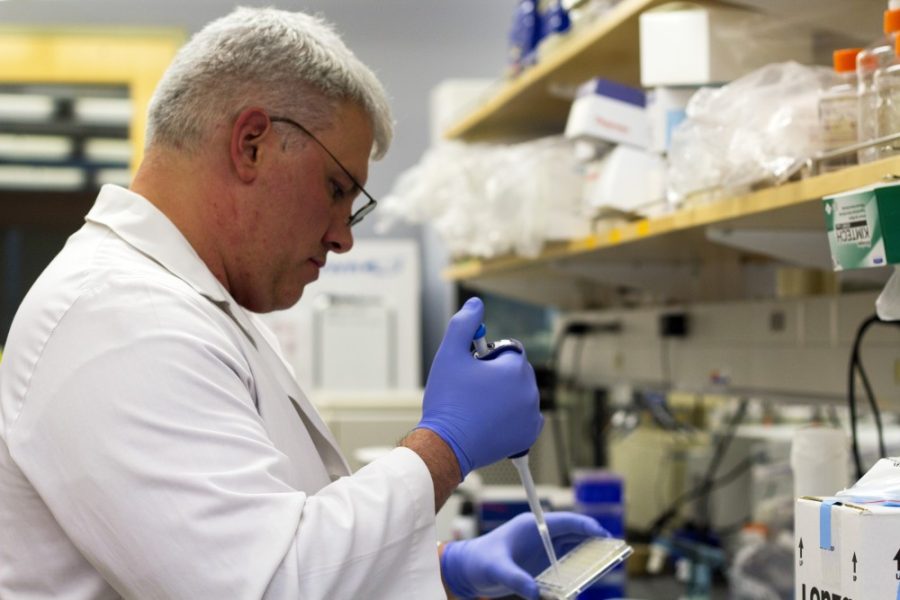Adam Buntzman, research assistant professor in the department of medicine, has brought together different departments in order to create the first map of the human immune system.
Certain patterns of immune receptor functioning are correlated to different disease outcomes in hospital patients.
The project analyzes the enormous array of immune receptors to find patterns that might correlate to good and bad immune responses, according to Buntzman. The bulk of the project has been going on for more than 10 years.
“There are a variety of clinical syndromes that occur that are directly and intimately tied to the adaptive immune system,” Buntzman said. “In the past, we haven’t been able to find those patterns [of] which ones of those receptors are good and which ones are bad.”
Because there are millions and millions of parts to the immune system, it was thought to be an impossible task to identify the patterns in the receptors. Buntzman compared it to finding a needle in a haystack.
Buntzman found that it was not as impossible as it seemed. He said that computers and other tools are necessary to count and analyze the patterns within the immune receptors, which makes collaborating with people who spend their lives making and designing computer chips essential.
“Low and behold, you find people who do a task that robustly,” Buntzman said. “The wonderful thing is: We have individuals on campus that do that very thing.”
The UA Department of Electrical and Computer Engineering was able to answer the call. Buntzman explained that he need these experts to help design, create and deliver computer chips that would work with this type of project.
RELATED: UA researchers work to get FDA approval of new coral snake anti-venom
Buntzman turned to Ali Akoglu, associate professor in the ECC department and BIO5 Institute, about four years ago for help on the immune system mapping project.
Akoglu said one day Buntzman showed up at his office after seeing his name and area of expertise on the BIO5 faculty list. From the first day, Akoglu said he could see Buntzman’s excitement and passion for discovery.
“The thing is that when you do collaborative research; it is not easy to find matching interests and good chemistry,” Akoglu said. “It turned out to be a really great adventure.”
The project was fortunate in regards to financing, according to Akoglu. This allowed the team to get started working quickly.
If Buntzman used traditional computer methods to create a map of the immune system, he said it would have taken over a hundred years. But the graphics processing unit Buntzman, Akoglu and Akoglu’s graduate student, Gregory Striemer, developed was able to run an analysis in about 17 days.
“Other groups have modeled the adaptive immune system but did so with a million [immune receptors] at a time,” Buntzman said. “We’re talking about us swamping the previous laboratories attempts by a couple trillion fold.”
He credits part of this accomplishment to the friends he made within different departments that were able help him.
RELATED: Steward Observatory celebrates 100 years since its founding gift
The next step for Buntzman is to find patterns within the data. He aims to learn which of the immune receptors are important.
This can be answered statistically and through collaboration with computer scientists, algorithm developers, mathematicians and database developers, according to Buntzman. With help from these departments, Buntzman and this project are able to store and calculate the information, pick out patterns and check if those patterns are correct.
Buntzman said they have already found a few patterns that are in the process of being published.
“Now you want to find patterns that can help people clinically,” Buntzman said. “[You want ones that] actually impact the way somebody is treated in the clinic or diagnosed in the clinic.”
Buntzman is currently working on developing tools to pull out patterns that relate to disease outcome.
“In various aspects of clinical medicine, we are planning to use it,” Buntzman said. “It is currently being assessed in multiple autoimmune diseases as well as tumor responses, and we’re hoping to expand into other inflammatory states like asthma.”
Buntzman said he thinks that this work will blossom significantly in the future and that he would not be in this position if not for his collaboration with other university departments.
Follow Elizabeth O’Connell on Twitter.














